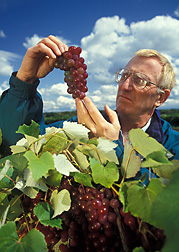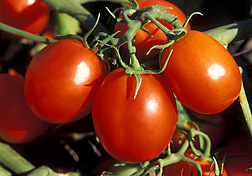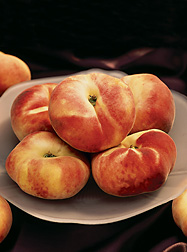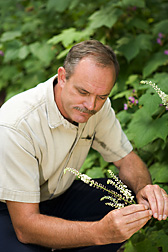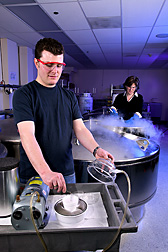Cream of the Crop
Genetic Preservation of Specialty Crops
|
|
During the 900-day German siege on Leningrad in World War II, the city’s food supply dwindled and eventually disappeared. More than half a million Russians starved to death, powerless against the fate imposed by a ruthless war. But some died willingly. In the world’s largest seed bank—stocked with hundreds of thousands of plant specimens by the Russian botanist Nikolai Vavilov and his colleagues—many staff members chose to die rather than consume the edible genetic materials they’d been maintaining since the 19th century.
Their sacrifice is an extreme and moving testament to the importance of preserving and protecting plant genetic material, or germplasm. Today, agriculture’s success relies on genetic uniformity, which supports large-scale food production. But crops are ultimately weakened by that same homogeneity, because it reduces their resistance to disease, pests, and environmental stresses. Genebanks promote the continuation of our food supply by conserving germplasm with valuable genetic traits that can be used to protect and improve our commercial crops.
The ARS National Plant Germplasm System (NPGS) includes more than 20 research locations around the United States where scientists safeguard specimens, or accessions, of agricultural crops and conduct research on genetic improvement. Many of these sites focus on preserving accessions of specialty crops. Some specialty crops make up a significant portion of our diet, so maintaining their genetic diversity is essential. But NPGS researchers don’t simply maintain germplasm. They also improve it. And their work has both national and global benefits.
Wild for Tomatoes
Tomatoes are a specialty crop, yet are among the highest grossing vegetables grown in the United States. Fresh and processed tomatoes net about $2 billion annually. But the tomatoes that grace our BLTs and marinara sauces have been thought to possess limited genetic diversity. One method of improving diversity is to breed cultivated tomatoes with wild tomatoes. Unfortunately, the resulting fruit tends to be unpalatable, says molecular biologist Joanne Labate.
Labate, computational biologist Angela Baldo, and geneticist Larry Robertson in ARS’s Plant Genetic Resources Unit at Geneva, New York, have found greater genetic variety in cultivated tomatoes than was commonly believed to exist.
Understanding how to effectively harness this variation could enable breeders to improve the U.S. tomato crop without relying on bitter wild plants.
|
|
The scientists examined publicly available sequence data from the National Center for Biotechnology Information. Using software that Baldo developed with Derek Huntley of Imperial College London, they identified potential small variations in DNA sequences—called “single nucleotide polymorphisms”—in 764 tomato genes.
“Of the 53 genes we examined in the lab, 21 revealed significant genetic variations that could be used to aid breeding decisions,” says Labate. “In fact, some breeders are already using the information to make genetic maps.”
Similar work at the Geneva unit—where scientists maintain more than 5,200 apple trees and 1,400 grape vines in the field—has potential benefits for commercial crops. On trips to central Asia, the probable ancestral home of modern apples, research leader Philip Forsline gathered genetic materials now maintained at Geneva and at the ARS National Center for Genetic Resources Preservation (NCGRP) at Fort Collins, Colorado. Some of those are sources of genetic resistance to common diseases, which breeders may soon be able to use. (See “Remarkable Kazak Apples,” Agricultural Research, January 2006, p. 4.) Nearly 2,500 of the apple field plantings at Geneva are backed up as cryopreserved—frozen—dormant buds at NCGRP.
The Geneva unit also maintains many North American grape species with genes for climate tolerance and disease resistance.
“These grapes can be used in hybridizing to create hardy and disease-resistant grapes for both fruiting grapes and grape rootstocks,” says Forsline. (See “A Focus on Grape Genetics,” Agricultural Research, April 2006, p. 9.)
All this research will eventually improve disease resistance, flavor, and nutrition for some of our most popular crops.
|
|
Not Just Your Garden Variety
The greater the variety of preserved accessions in a collection, the more genetic resources will be available for breeding new and improved varieties.
More than 450 olive trees, representing 147 cultivars from some 2 dozen countries, flourish in America’s official olive collection, grown in the research orchards of the ARS National Clonal Germplasm Repository for Fruit and Nut Crops. Headquartered at Davis, California, this genebank is a permanent haven not only for rare, wild, and domesticated species of olives, but also for unique specimens of familiar crops, such as grapes, kiwis, peaches, almonds, and walnuts.
Though humans have grown olives for more than 4,000 years—using them in lunches, lamp oils, and lubricants—modern science has yet to reveal the secrets of many of their healthy compounds. Current studies are examining the nutritional influence of olive oil, which is increasingly linked to improved cardiovascular health. Other studies may yield important clues to breeding superior trees that bear fruit with greater resistance to olive fruit flies.
Germplasm collections can also help reduce the impact of diseases and other stresses. At the Woody Landscape Plant Germplasm Repository (WLPGR)—part of the U.S. National Arboretum’s Floral and Nursery Plants Research Unit—ARS maintains 5,700 living plants. There, curator Kevin Conrad and his colleagues are working with native plants that are under pressure for survival, such as black cohosh and ash.
Black cohosh is a herbaceous wildflower, native to the eastern United States. With creamy white flowers clustering around tall spikes, it is used as an ornamental. But black cohosh is gaining popularity as a treatment for bothersome symptoms of menstruation and menopause. In fact, its reputation as a remedy is part of its problem, as pressure from herbalists threatens to overwhelm the wild plants. Consequently, the arboretum is collecting and conserving accessions for future research.
Ash trees—also popular landscaping ornamentals—face environmental pressure in the form of the emerald ash borer. Since this pest’s discovery in the United States in 2002, its larvae have killed more than 20 million ash trees here. The WLPGR is part of a national effort to gather and protect ash germplasm so that when scientists find a solution to the problem, they will be able to rebuild the population from a foundation of genetic diversity.
“We’re trying to prevent a repeat of what happened with Dutch elm disease [DED],” Conrad says. “DED wiped out millions of American elms before we had national efforts to preserve genetic diversity.”
As a result, when arboretum scientists released two DED-resistant American elms in 1995, the trees represented a very small part of the elm gene pool. By stockpiling germplasm now, Conrad and his colleagues hope to protect plants like ash and black cohosh from a similar fate.
Going to Seed—Globally
ARS preservation research benefits repositories both within the United States and elsewhere. Researchers at the Fort Collins center have developed methods to cryopreserve Jerusalem artichoke (sometimes called “sunchoke”). Neither an artichoke nor from Jerusalem, this sunflower relative is nutritious and versatile. It can be eaten raw, boiled, or roasted—plain or on a salad.
The ARS North Central Regional Plant Introduction Station in Ames, Iowa, maintains 99 Jerusalem artichoke accessions, 22 of which are available as seed, “which is much simpler to manage than tubers,” says curator Laura Marek. But the plants don’t always make seeds, so NCGRP plant physiologist Gayle Volk and ARS colleagues developed cryopreservation methods for shoot tips that will form new plants.
Working with researchers from the Canadian Genetic Resources Program, the ARS scientists found they could reliably create shoot tips for cryopreservation by introducing buds from the rhizomes into a tissue culture. This method has been used successfully to back up accessions from field collections.
“This research has allowed us to improve our storage methods,” Volk says. It also reduced the time and cost of Jerusalem artichoke maintenance for the Canadian collection, which contains about 150 accessions.
Some of the world’s most diverse germplasm collections are maintained by ARS, and they are stocked with plants from around the globe. ARS scientists follow international regulations to collect wild species from their native habitats so that unusual genetic resources can be conserved for future generations.
The ARS National Clonal Germplasm Repository (NCGR) in Corvallis, Oregon, maintains accessions from 19 species of strawberries, gathered from 37 countries. On expeditions to Russia and Japan, Kim Hummer, curator for the USDA strawberry collection, collected several Asian small fruit species, including strawberries. Wild Asian strawberry species may be closely related to ancestors of those cultivated in North America.
Assessing the genetic diversity of these species is an important step towards developing effective collection and preservation strategies for wild species. NCGR molecular geneticist Nahla Bassil is working with Ph.D. student Wambui Njuguna at Oregon State University and colleagues in ARS and at the University of New Hampshire to investigate the genetic diversity and inheritance patterns of wild and cultivated strawberries.
“Conserving wild and cultivated strawberries gives breeders and scientists a larger, more complete genetic base to select from when trying to improve cultivars or conduct research,” Bassil says.
These accessions are available to researchers around the world, but that’s not the only way that ARS collections benefit the global community.
NCGR researchers have been working with two international organizations to develop a global conservation strategy for strawberry genetic resources. In July 2006, NCGR hosted an international panel to assess the status of strawberry conservation and develop protocols for conservation standards.
“These efforts could make resources available to developing countries to upgrade their conservation efforts. This, in turn, will give greater protection to wild species and provide accessibility to previously unavailable genetic resources,” says Hummer.
A full list of the repositories in NPGS is available online at www.ars-grin.gov/npgs/rephomepgs.html.—By Laura McGinnis and Marcia Wood, Agricultural Research Service Information Staff.
This research is part of Plant Genetic Resources, Genomics, and Genetic Improvement, an ARS national program (#301) described on the World Wide Web at www.nps.ars.usda.gov.
To reach scientists mentioned in this article, contact Laura McGinnis, USDA-ARS Information Staff, 5601 Sunnyside Ave., Beltsville, MD 20705-5129; phone (301) 504-1654, fax (301) 504-1486.
"Cream of the Crop: Genetic Preservation of Specialty Crops" was published in the October 2007 issue of Agricultural Research magazine.







